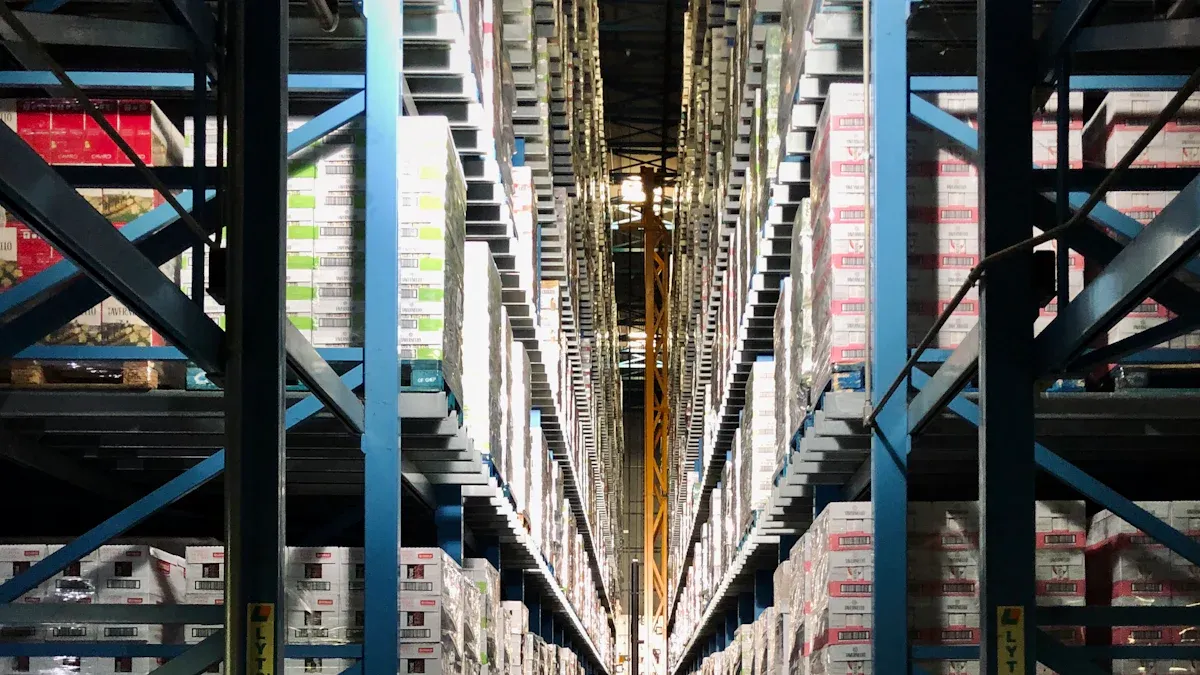From Cost Center to Value Driver: AI’s Role in Transforming Supply Chain Economics

Supply chains have transitioned from functioning solely as cost centers to emerging as pivotal value drivers. This shift is driven by the integration of AI, which streamlines operations and elevates decision-making processes. Companies leveraging AI are experiencing substantial advantages, including cost reductions of up to 20%, inventory enhancements by 35%, and a forecasted increase in adoption in the coming years.
Key Takeaways
AI changes supply chains from money spenders to value creators. It helps with better decisions and smoother operations.
Businesses using AI can save up to 20% in costs. They can also manage their stock better by 35%.
To use AI well, companies should ensure good data. They should try small projects first and encourage creative thinking.
Understanding Supply Chains as Cost Centers
Characteristics of Cost-Centric Supply Chains
Historically, supply chains have been viewed as necessary cost centers, focusing on minimizing expenses rather than creating value. Companies prioritized reducing direct and indirect costs associated with production, transportation, and procurement. This approach aimed to streamline operations and align supply chain strategies with consumer expectations.
Key characteristics of cost-centric supply chains include:
Key Characteristics | Quantitative Parameters |
|---|---|
Understanding direct and indirect costs | Inventory levels |
Investment decisions | Transportation methods |
Transportation costs | Demand forecasting |
Purchasing costs | Cost optimization metrics |
These supply chains often relied on rigid processes and traditional metrics to measure success, such as cost reduction and efficiency improvements. While effective in controlling expenses, this model lacked the flexibility to adapt to dynamic market demands.
Limitations and Challenges of Traditional Models
Traditional supply chain models face significant limitations in today’s fast-paced business environment. Incomplete or inconsistent data often leads to inaccurate decision-making. Many organizations struggle with outdated systems that cannot support advanced analytics, creating technological barriers.
Other challenges include:
Complexity in analyzing vast amounts of data, making it difficult to identify relevant trends.
Resistance to change within organizations, which slows the adoption of innovative practices.
Rapid market changes that render static models ineffective.
These limitations highlight the need for a shift from cost-centric approaches to value-driven strategies. By embracing modern technologies like AI, companies can transform their supply chains from a cost center to value driver, unlocking new opportunities for growth and resilience.
The Concept of Value-Driven Supply Chains

Defining Value-Driven Supply Chains
Value-driven supply chains prioritize creating measurable benefits over simply cutting costs. This approach focuses on enhancing collaboration, agility, and responsiveness, which are essential for modern supply chain management. Businesses adopting this model aim to align their supply chain strategies with broader organizational goals, fostering growth and innovation.
Key attributes of value-driven supply chains include:
A shift from cost reduction to value creation, improving profitability and performance.
Enhanced collaboration across stakeholders, ensuring seamless operations.
Agility to adapt to market changes and disruptions effectively.
Organizations that fail to transition from traditional cost-based models risk stagnation. By embracing value-driven strategies, companies can unlock new opportunities and position themselves as leaders in their industries.
The Role of Technology in Driving Value
Technology plays a pivotal role in transforming supply chains from cost centers to value drivers. Advanced tools like artificial intelligence (AI) and machine learning enable businesses to optimize operations and predict disruptions. Digital twin modeling allows companies to simulate scenarios, improving risk management.
Other impactful technologies include:
IoT Devices: These provide real-time monitoring, enabling predictive maintenance.
Blockchain: This ensures transparency and accountability across the supply chain.
Predictive Analytics: It identifies potential geopolitical risks, enhancing decision-making.
The integration of these technologies has led to measurable improvements in supply chain value. For instance, AI-driven demand forecasting customizes projections based on real-time data, reducing inventory costs and improving customer satisfaction.
Evidence | Description |
|---|---|
Cost-benefit trade-offs | Highlights the need for value-driven approaches. |
Total cost of ownership | Emphasizes the importance of a comprehensive cost view. |
Cost optimization | Maximizes returns while ensuring reliable supply. |
By leveraging these advancements, businesses can achieve a competitive edge, ensuring their supply chains drive value rather than merely managing costs.
AI’s Role in the Shift from Cost Center to Value Driver

Demand Forecasting and Inventory Optimization
AI revolutionizes demand forecasting and inventory optimization by leveraging historical data and real-time analytics. Businesses can predict customer demand with greater accuracy, reducing stockouts and excess inventory. For example, Church Brothers Farms achieved a 40% improvement in short-term forecasting accuracy, minimizing carrying costs and enhancing production planning.
AI-driven insights also enable dynamic inventory replenishment strategies. By analyzing sales trends and inventory levels, AI automatically generates recommendations, ensuring optimal stock levels. This proactive approach prevents disruptions and improves operational efficiency. Companies transitioning from traditional methods to AI-powered systems unlock measurable benefits, transforming their supply chains from cost centers to value drivers.
Logistics and Transportation Efficiency
AI enhances logistics and transportation efficiency through intelligent route optimization and predictive analytics. By analyzing traffic patterns and fuel consumption, AI reduces delivery failures and improves on-time delivery metrics by up to 20%. Predictive models also enhance inventory accuracy, ensuring products reach customers faster and with fewer errors.
A notable example includes AI-driven systems that reduce fuel usage by up to 10%, contributing to cost savings and sustainability goals. These advancements redefine logistics operations, enabling businesses to achieve operational excellence while reducing expenses. AI’s ability to optimize transportation networks positions it as a critical tool for transforming supply chain economics.
Risk Management and Resilience
AI strengthens supply chain resilience by enabling proactive risk management strategies. Real-time monitoring and predictive algorithms anticipate disruptions, allowing companies to implement contingency plans. For instance, during delays at West Coast ports, AI-powered dashboards provided actionable insights, helping businesses mitigate risks effectively.
Diversification and scenario simulations further enhance resilience. AI evaluates supplier performance and identifies vulnerabilities, ensuring businesses remain agile in the face of uncertainty. By integrating AI into risk management frameworks, organizations build robust supply chains capable of adapting to dynamic market conditions.
Enhancing Supplier Collaboration and Visibility
AI fosters stronger supplier collaboration and visibility by automating processes and improving communication. Predictive insights align production schedules with supplier capabilities, reducing inefficiencies. AI-powered platforms also facilitate real-time data sharing, enabling seamless collaboration across supply chain stakeholders.
Dynamic risk scoring and smart contract management further enhance supplier relationships. AI evaluates supplier performance and automates agreements, ensuring accountability and transparency. These capabilities transform supplier interactions, driving value creation and operational excellence. Businesses leveraging AI for supplier collaboration redefine their supply chains as engines of growth rather than cost centers.
Actionable Steps to Adopt AI in Supply Chains
Identifying High-Value Use Cases
Organizations must begin their AI journey by pinpointing areas where AI can deliver the most value. This involves evaluating current operations to uncover inefficiencies and opportunities for improvement. For instance, businesses can analyze customer experiences to identify friction points or benchmark against competitors to discover missed opportunities.
Key steps include:
Mapping existing supply chain processes to create a clear blueprint for AI integration.
Assessing technological infrastructure and ensuring data availability and accuracy.
Prioritizing use cases based on potential ROI and alignment with strategic goals.
AI-driven demand forecasting is a prime example of a high-value use case. By analyzing historical data and market trends, AI can predict seasonal demand fluctuations, enabling businesses to optimize inventory and marketing strategies. In 2023, 45% of organizations used AI for demand forecasting, highlighting its growing importance in supply chain management.
Piloting and Scaling AI Applications
Pilot projects allow businesses to test AI solutions on a smaller scale before full implementation. These projects help validate AI’s effectiveness and identify potential challenges. For example, 57% of enterprises are either implementing or expanding AI projects, with 70-75% reporting clear value from these initiatives.
To scale successfully, companies should:
Start with a focused pilot addressing a specific supply chain challenge.
Measure outcomes using metrics like cost savings, efficiency gains, and customer satisfaction.
Gradually expand AI applications across the supply chain, ensuring alignment with organizational goals.
Scaling successful pilots, as seen in industries like healthcare and logistics, ensures that businesses maximize the benefits of AI while minimizing risks.
Investing in Data Quality and Integration
High-quality data forms the backbone of effective AI systems. Companies must prioritize data integrity, accessibility, and error reduction to ensure reliable AI-driven insights. Metrics like process efficiency and financial returns demonstrate the tangible benefits of investing in data quality.
Metric Type | Description |
|---|---|
Data Integrity | Ensures accuracy and reliability of data for AI systems. |
Accessibility | Measures how easily data can be accessed for timely decision-making. |
Process Efficiency | Quantifies workflow improvements due to AI, showcasing operational gains. |
By integrating data across systems and eliminating silos, businesses can unlock the full potential of AI. Real-time data collection and analysis further enhance inventory management and shipment tracking, driving operational excellence.
Building a Culture of Innovation
A culture of innovation ensures that employees embrace AI and other transformative technologies. Companies like Apple and Amazon have demonstrated the benefits of fostering innovation in supply chain management. Apple’s demand-driven approach optimized production and reduced inventory costs, while Amazon’s use of robotics improved operational efficiency.
To build this culture, organizations should:
Encourage collaboration across teams to identify and implement innovative solutions.
Provide training programs to upskill employees and reduce resistance to change.
Recognize and reward innovative ideas that drive measurable improvements.
By prioritizing innovation, businesses can position themselves as leaders in their industries, ensuring their supply chains remain agile and competitive.
AI has revolutionized supply chain economics, transforming operations into value-driven systems.
47% of leaders recognize AI’s unmatched potential in supply chain optimization.
It enhances logistics efficiency, real-time pricing, and predictive planning.
Adoption rates are projected to surge by 2025, driving sustainability and accuracy.
Organizations must act now to harness AI’s transformative power and secure a competitive edge.
FAQ
What are the key benefits of using AI in supply chains?
AI enhances supply chain efficiency by improving demand forecasting, reducing costs, and increasing agility. It also strengthens risk management and fosters better supplier collaboration. 🚀
How can businesses overcome challenges in AI implementation?
Companies should invest in data integration, modernize legacy systems, and foster a culture of innovation. Training programs and pilot projects can ease transitions and ensure success. 💡
Is AI adoption in supply chains expensive?
AI implementation requires upfront investment, but the long-term benefits—cost savings, improved efficiency, and competitive advantage—far outweigh the initial expenses. Think of it as a strategic asset. 💰
See Also
Enhancing Productivity Through Innovative AI Supply Chain Solutions
Transforming Logistics for the Future with AI Supply Chains
Exploring AI Integration for the Next Generation Supply Chain
Understanding Cost Efficiency in Supply Chain Economics Today
Leveraging Big Data and Machine Learning for Supply Chain Success
